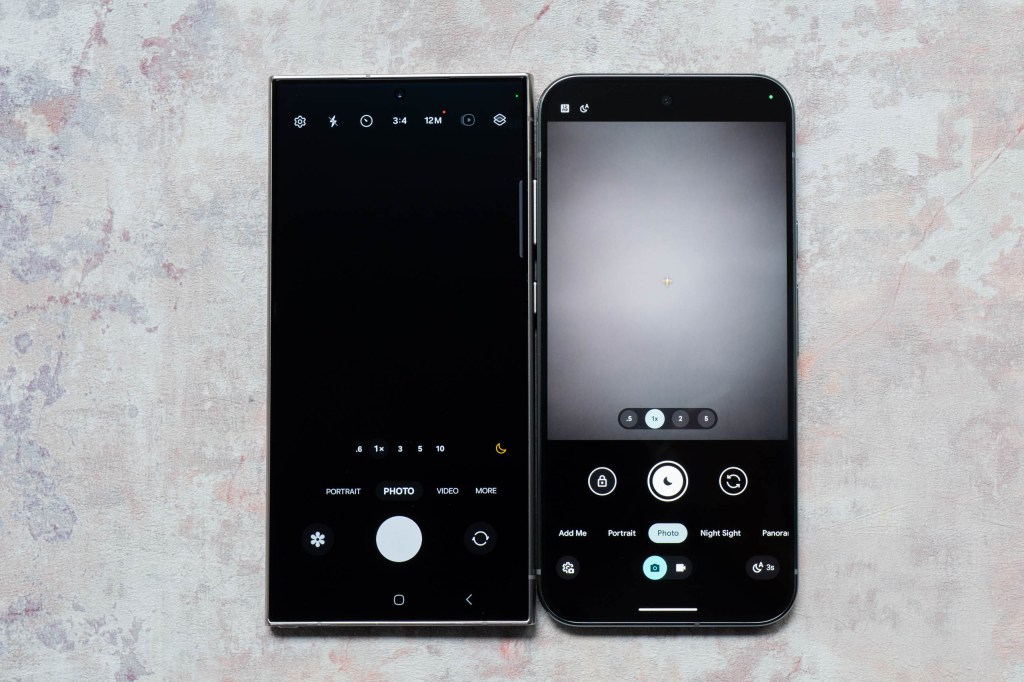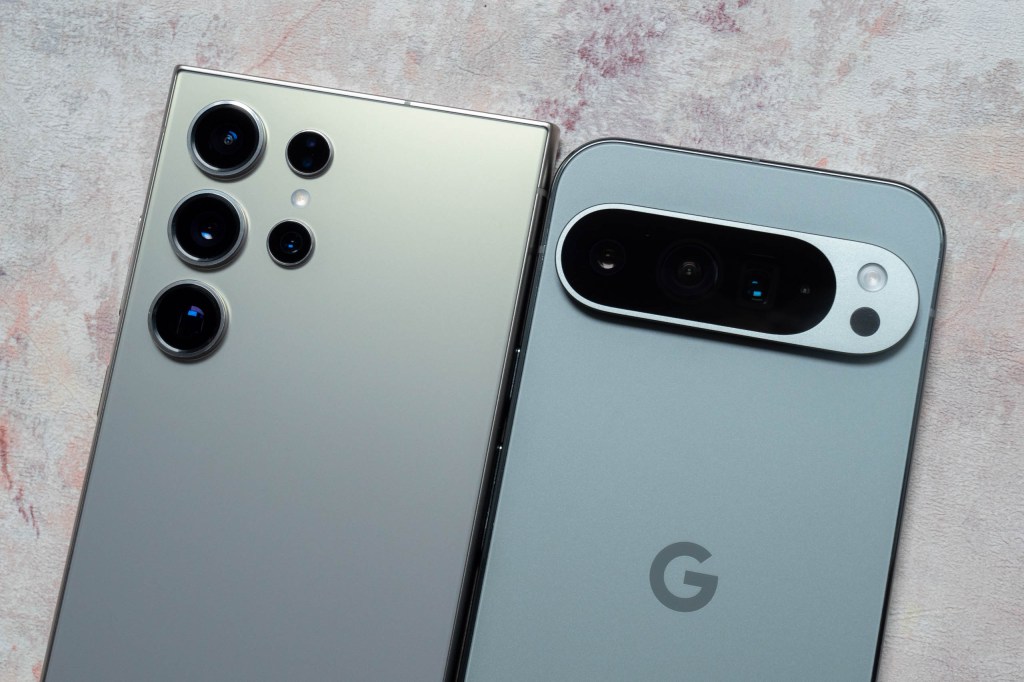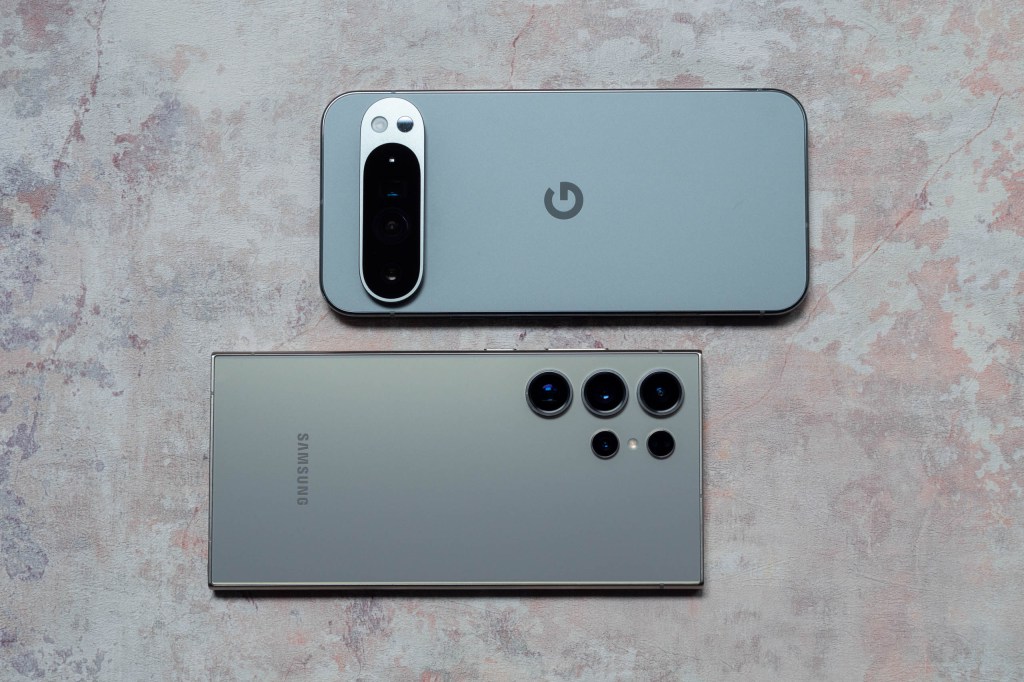If you’re interested in picking up one of the best smartphones for photographers, then two of the big name choices are the Samsung Galaxy S24 Ultra and the Google Pixel 9 Pro XL, both of which have excellent specifications for photographers.
In our standalone reviews of both these phones, we found that they are capable of producing excellent results. But now it’s time to put them squarely head to head and see which one comes out best. As such, I’ve used the phone to photograph a range of different scenarios to better see the differences.

With the Google Pixel 9 Pro series, there’s two screen sizes – 6.3-inch, or 6.8-inch. Therefore, this can also be considered a comparison with the Pixel 9 Pro, if you prefer the smaller screen size. Sadly, there’s only one size variant for the Samsung S24 Ultra.
Google Pixel 9 Pro XL vs Samsung S24 Ultra: Specs
In the table below I’ve compared the two phones, taking into account specifications that will likely primarily appeal to photographers. Where something is better, I’ve bolded it – there’s bold to be seen on both sides of the table.

With regards to the cameras, there’s four available on the Samsung Galaxy S24 Ultra, but only three for the Google Pixel 9 Pro XL. The main sensor on the Samsung has 200MP, while the Pixel’s is “only” 50MP. It’s worth pointing out that either way, the standard output is 12MP though.
Both have an ultrawide lens, and both have a 5x zoom lens. But the Samsung has an additional 3x zoom as well to add to the mix.
| Samsung Galaxy S24 Ultra | Google Pixel 9 Pro XL |
| 200MP f/1.7 main camera, OIS, 12MP output, 24mm | 50MP f/1.68 main camera, OIS, 12MP output, 25mm |
| 12MP f/2.2 ultrawide camera, 13mm | 48MP f/2.8 ultrawide camera, 12MP output, 12mm |
| 50MP f/3.4, 5x telephoto camera, 111mm | 48MP f/2.8 5x telephoto camera, 113mm |
| 10MP f/2.4 3x telephoto camera, 67mm | No fourth camera |
| 12MP f/2.2 selfie camera, AF | 42MP f/2.2 selfie camera, AF |
| 8K 30fps | 4K 60fps / 8K “upscaling” via the cloud |
| 6.8-inch 3120 x 1440 pixels, 2600 nits brightness | 6.8-inch Super Actua OLED 2992 x 1344 pixels, 3000 nits brightness |
| Qualcomm Snapdragon Gen 3 | Google Tensor G4 |
| 30 hour battery life, wireless and Fast (45W) charging available | 24 hour+ battery life, wireless and Fast (45W) charging available |
| 256GB, 512GB, 1TB storage | 256GB, 512GB, 1TB storage |
| 162.3 x 79 x 8.6mm, 233g | 162.8 x 76.6 x 8.5mm, 221g |
In terms of other specs to think about – take a look at the screen. Both of these models have a very large 6.8-inch screen, which can be quite cumbersome to use. However, with the Pixel 9 Pro, you can get a smaller 6.3-inch device but keep the exact same camera set up. Otherwise, the Pixel is brighter, but the Samsung has higher resolution. The Samsung also has impressive anti-reflective technology for its screen, too. It’s also worth noting that the Samsung comes with an S Pen Stylus, which you can use to trigger the camera’s shutter remotely – useful for group portraits and so on.

The native camera apps for both of these phones is quite extensive. Both have “pro” options, and both can shoot in raw. There’s a slew of additional AI-type features for the Pixel phone however, such as the fun “Add Me” feature – where you can take group shots without needing an additional person to take the photo. Both offer a good degree of editing within the native apps, too, again including plenty of AI editing options.
Image Quality
I took photographs with both the Samsung Galaxy S24 Ultra and the Google Pixel 9 Pro XL across a variety of situations to directly compare image quality, and here are the results.
Note, the S24 Ultra is on the left every time, and the Pixel 9 Pro XL is on the right every time.


On the whole, both phones produce excellent images. Here, we’ve got the same scene shot with the 1x lens in both instances. Both are great but the Samsung has gone a little overboard with the colours, giving us unrealistic colours in both the sky and the sea. By contrast, the Pixel has boosted reality a little bit, so as to be pleasing, but without going too far. Both have plenty of detail, with perhaps just a touch more detail from the Samsung if you zoom in quite closely.


Here again we can see the differences in colour, with the sky on the Samsung shot very saturated. Arguably of course you might prefer this look, and it certainly gives landscapes shot a “zing” that arguably the Pixel doesn’t achieve in quite the same way.


Here we’ve got the Samsung’s 3x lens, but the Pixel doesn’t have one of those. Instead, I’ve compared it against the 2x digital zoom option, as that is an option that is directly displayed within the native camera app. This 2x option very closely matches the Samsung’s 3x lens in terms of detail and quality – showing that you don’t necessarily need that extra lens.


Both of the phones have a 5x zoom lens. Looking at them side by side, they’re very closely matched in quality, with both showing roughly the same level of detail and similar colour output. Both are not as good as the images produced by the 1x lens, but that’s what we’d expect.


With the Samsung S24 Ultra, you’re promised up to 100x digital zoom, while the Pixel 9 Pro XL gives you a more staid 30x. However, the 100x is very definitely a marketing gimmick, generally producing unusable images. Even 20-30x from both phones produces fairly unimpressive results. However, the 10x option from both is quite solid. Remember that Samsung decided to ditch its 10x lens in favour of a high-resolution 5x lens for the S24 Ultra, suggesting that the digital 10x version was just as good as the previous 10x optical one. Both of the images seen here are pretty usable for social media sites and the like, but if you zoom in you can see a loss of detail quite clearly. The two pictures are fairly evenly matched, with perhaps a slightly better result from the Pixel 9 Pro XL.


Both the Samsung and the Pixel use the ultrawide lens by default for macro work. The result is pretty good from either option, but the Samsung is a little bit brighter and a little bit cleaner if you look closely.


Both models produce great images when shooting in low light, thanks to Night modes. These modes should automatically activate when low light levels are detected, but with both you can also manually switch them on. I prefer the colours from the Samsung, but, there’s marginally more detail in the shadow areas from the Pixel. Note that I carry out this assessment looking at the pictures on a large screen – the differences are much harder to spot on a phone screen.


Again with the ultrawide lenses, we have similarly pleasing results from both phones. There’s better colours again in the Samsung, but again marginally more detail in the shadow areas with the Pixel.


Just like with the good light shot, I’ve compared the 2x digital from the Pixel phone with the 3x optical lens from the Samsung here. The Pixel’s looks OK on a phone screen, but on a larger computer screen you can easily see that it’s quite smudgy, while the Samsung’s looks quite a bit better. Both should be fine for social sharing, however.


Here there’s more of a marked difference. The 5x lens from the Samsung, despite having a narrower aperture of f/3.4, seems to have produced a much better image than the 5x f/2.8 lens from the Pixel. The Pixel’s image is very smudgy and misses out a fair amount of detail. With either I’d probably be inclined to avoid using the 5x zoom lens when shooting in similar situations.


With both models you can shoot in a dedicated Portrait mode to create shallow depth of field effects. With the Samsung, you can shoot at 1x, 3x or 5x. The Pixel is restricted to either 1.5x or 2x, which is a bit of a shame. Both produce fairly good results, with good detail and a nice fall off in focus to the background. The Pixel has produced nicer colours however, especially regarding skin tones.


Considering its price point, the Samsung S24 Ultra has a somewhat disappointing selfie camera, only being 12MP. Meanwhile, the Pixel has a 42MP selfie camera, which sounds like it should be better in theory – though it should be noted that the output from it is 10.5MP. The Pixel selfie has more pleasing colours, being darker and richer, while the blur is nicer, too. Note that you can edit the level of blur with either phones – this is the standard / default option.
Price and Value for Money
There’s no way anyone would consider either of these models to be for the budget conscious. However, it’s also true that opting for a high-end like this phone should see you able to keep hold of it for quite a while.
It’s a shame that Google’s Pixel prices have risen quite a bit in recent years – they used to be quite a good budget option, but now have prices roughly in line with other flagships. That said, you can save money here by opting for the smaller Pixel 9 Pro, if you’re happy enough to have a smaller screen but still want the best camera.

Pixel 9 Pro prices are: $999/£999 (128GB), $1099/£1099 (256GB), $1299/£1299 (512GB) and $1499/£1499 for 1TB. If you want the bigger version, prices are $1099/£1099 (128GB), $1199/£1199 (256GB), $1399/£1399 (512GB) or $1599/£1599 for 1TB.
For the Samsung Galaxy S24 Ultra, you’ll be looking at $1299/£1099 (256GB), $1419/£1199 (512GB) or $1659/£1399 (1TB).
As you’ll see there’s a bit of a disparity in prices, depending on which territory you’re in. If you’re in the US for example, the Pixel comes in as the cheaper option, while in the UK, it’s the Samsung.

It’s also worth remembering the second-hand market, the Samsung is older so you’re more likely to find some available at cheaper prices that way. You should also take note of how well the brand is likely to hold its price when it comes to resale or trade-in – a Samsung is likely to be worth more in the future than a Pixel.
Verdict
Both of these Android phones would make an excellent choice for photographers looking for the best camera possible.
It’s another one of those times when it’s hard to pick an overall winner as both produce good shots across a range of conditions. On the whole though, I’d probably say I prefer the Pixel, with its slightly more muted (but more realistic) colours. Others may feel differently here though, so it’s a pretty subjective opinion.

In terms of apps and handling, the Pixel has a few more fun options going for it, so I’d also put it ahead there, just about. As for price, as we have seen, it depends on where you are on which is the cheapest – but the Samsung is arguably better value for money as it’s likely to keep its value a bit better than the Google.
Ultimately, these two Android flagships are very closely matched. Which you might choose to buy may come down to a number of factors, not necessarily limited to the quality of the onboard camera.
Read more smartphone comparisons:






